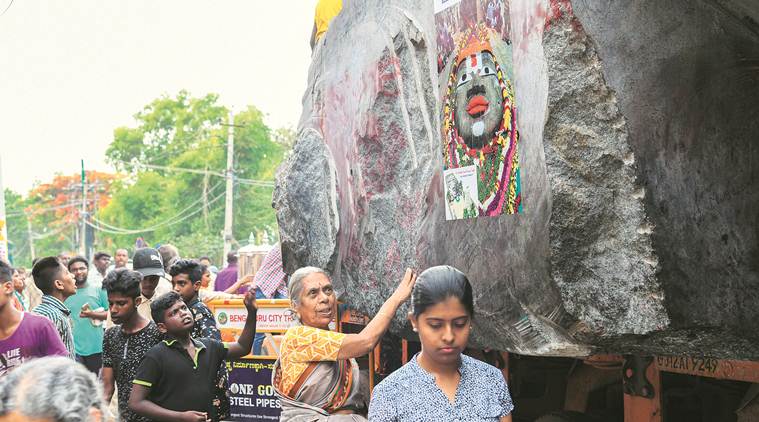
Faith can move mountains — but it might take seven months to cover 300-odd km, and also knock down a few houses, shops, walls and electric poles along the way.
For seven months now, a colossal slab of granite, weighing 420 tonnes, quarried from a hill in Korakottai village in Tiruvannamalai district, Tamil Nadu, has been travelling on a vehicle with 240 wheels, as it makes its way to a temple in Bengaluru’s Ejipura.
It is no ordinary stone, but an unfinished monolith statue (64 feet high, 25 feet wide) of Vishwaroopam, a figure believed to represent the 10 avatars of god in Hinduism.
“This is the supreme bhagwantam, who came to the aid of Hindus by taking on different avatars at different times… There is no unity among Hindus because we believe in different gods… So, I decided to build a statue wherein all the Hindu gods are engraved on the body of the Lord,” said Dr Sadananda, a maverick doctor who, inspired by the Bhagvad Gita, embarked on this mission about seven years ago.
The Kothandaramaswamy Charitable Trust, headed by Sadananda, is bearing the cost of this adventure. Of the Rs 2.5 crore spent already, transport alone has cost Rs 1.8 crore.
“It was delayed because the roads had to be widened. Some houses and shops had to be broken, and then compensated,” said Tiruvannamalai collector K S Kandasamy, who was appointed the nodal officer for the transport of the rock by the Tamil Nadu government.
After crossing four districts and two states, the statue now rests at a street corner in Ejipura, at the mouth of a narrow lane that leads to the Kodanda Rama Swami temple, which was built by Dr Sadananda’s father 75 years ago. The final 400-odd metres will take about four days to cover, said Dr Sadananda, 65.
Standing in the way now are a cluster of electric poles. “Once they are uprooted, we can move inside. For that period, this area won’t have power,” says Naseem Khan, who took turns with three other drivers to manoeuvre the massive vehicle and its unusual cargo. “On good days, we would cover 10 km a day. Sometimes much less,” he said.
The statue arrived in Bengaluru over a week ago. “We had to do some road modification from Hosur to Ejipura. Some medians had to be modified. Now, in the last stretch, we have to remove a few electric poles,” said K V Jagadeesh, DCP (traffic-east).
Dr Sadananda identified the stone, which can be polished to a blackish blue, in 2012, after an extensive recce of villages in Tiruvannamalai. It took him two more years to get the requisite clearances.
But in 2017, when the rock was about to be shifted, a PIL was moved in the Madras High Court against its transport. After that was disposed of, the one-and-a-half axle vehicle began its long journey in November last year.
The first hurdle came in Vellimedupete village in Villupuram district, where the vehicle ended up ramming into houses and shops abutting a narrow carriageway. “We were not that experienced. The truck driver drove very harshly. In that village alone, I had to pay Rs 25 lakh as compensation,” said Dr Sadananda.
The trust had offered to pay to break down the wall of the 9th Century Senji fort in Villupuram, in order to access the highway. “But the archaeological authorities refused and so we had to reroute,” said Kandasamy.
Another setback to the transport came from the National Highways Authority of India (NHAI). “The NHAI refused us permission to cross small bridges and culverts on the way, as they feared the weight would be too much,” said Kandasamy.
“I had to build 8-10 ramps/diversions on my own, ranging from 1.5 km to 3 km in length. Each cost Rs 8-10 lakh,” said Dr Sadananda.
Two such ramps ran into stiff local resistance. One was allegedly built over the bed of Markandeya river in Krishnagiri district in February. Another ramp was built over the Thenpennai river in Hosur, near the Perandepalli bridge, allegedly blocking the course of the river.
“We turned the flow by dumping mud… We are going to remove everything eventually… It is just that we have been busy,” said Dr Sadananda.
The Tamil Nadu government and officials, he said, supported him “99 per cent”. But his message of Hindu unity also came up against the hostility of the residents in Tamil Nadu. “They asked, why should we give our stone to Karnataka when they haven’t given us Cauvery water,” said Kandasamy.
For a moment in Villipuram, said Dr Sadananda, when residents climbed on to the statue, refusing to let it move, “it seemed like Babri Masjid”. “When I finally crossed the border into Karnataka, I felt like Captain Abhinandan,” he said at the temple.
The compound resembles a construction site, with a JCB roaring in the background. The front wall has been demolished to make way for the stone.
“Once it is here, it will take another two years for sculptors from Tirupati to carve the full statue,” said Dr Sadananda, who left his full-time job as a professor of surgery in a medical college for this task. “I have been harassed no end and only because I am an ordinary man… I have taken three loans to finance it… But I was convinced that the supreme god deserved no less than such a huge statue,” he said to The Indian Express.
The statue has now reached the temple gate.